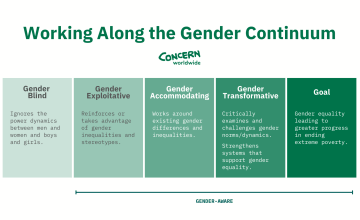
Read our 2023 annual report

Knowledge Hub
Earlier this year, the Irish Human Rights and Equality Commission launched a new statutory Code of Practice to help eliminate pay inequality.
While legislation passed by the Dáil has long provided for equal pay for equal work, much of this has been simply the beginning of an even more complex debate.
Arguments over appropriate data and the root causes of continuing pay inequity continue to this day, but one fact is indisputable: In 2022, the gender pay gap remains an issue for every single country in the world. It especially affects nations with higher rates of poverty, and is one of the barriers to ending extreme poverty.
In this guide, we go over some of the most common gender pay gap myths, while offering up some concrete facts, and adding some suggestions on what needs to happen to ensure real progress towards gender equality — in salaries and beyond.
Fact: Many popular statistics about the gender pay gap are misleading
You may have heard the popular claim that women make just 78 cents for every dollar that their male counterparts earn. This is true, at least in the United States. A survey from the Bureau of Labour Statistics (BLS) confirmed that number as recently as 2015. In Ireland, the most recent figures from 2019 suggest that women make closer to 86 cents for every euro. Yet this gap can increase or decrease based on specific details, including the industry, nature of work, and geographic location.
This figure doesn’t tell the whole story, but that doesn't mean the entire concept is flawed.
Myth: The gender pay gap is a myth
As mentioned above, some of the statistics quoted around the gender pay gap are misleading (and in some cases, outdated or just plain inaccurate). However, using these errors as an excuse to discredit the idea of gender disparity in pay is also misleading. The World Economic Forum (WEF), which publishes an annual report on gender equality across sectors, not only considers the actual figures earned by men versus women, but the gap between these salaries based on similar roles. The WEF’s latest report shows a median income gap of 13.5% to 15%. Some UN estimates go as high as 30%.

Fact: There are disparities within this disparity
The gender pay gap is wider still for marginalised communities, such as women of colour - and both the US’s 78-cents figure and Ireland’s 89-cents figure are far higher than the global average. The World Economic Forum’s global average suggests that women earn as little as $0.55 on the dollar (€0.53) compared to white, non-Hispanic men. Other data from the Organisation for Economic Cooperation and Development suggest that a woman’s salary drops for every child she has, as well as evidence that the inverse is true for men: A father’s salary increases for every child he has.
Through Concern’s work with inequality and marginalisation, we know that race and ethnic heritage are not the only ways that women lose out. These inequalities are often intersectional, especially when it comes to earning potential. Factors like the number of children they have can keep many women further from the best-case wage gap. Women in sub-Saharan Africa without children, for instance, only make 4% less than their male counterparts. Women with children? 31% less.
Myth: The wage gap exists because women choose lower-paying careers
True, women are more likely than men to have lower-paying jobs, but this is also a nuanced statistic. Women are more limited than men in terms of livelihood options due to gender discrimination (especially in STEM fields such as science, technology, engineering, and mathematics — subjects that women perform well in at school but tend not to follow as careers). Sexual harassment and gendered violence also keep women out of certain workplaces and even whole industries.
In countries that rely on agriculture and pastoralism for employment, women are hindered by traditions around land rights. In the words of our activist friend Bono, “They can work the land, but they can’t [expletive] OWN the land.” Also, female farmers often lack access to the same tools, seeds, and other resources as their male colleagues, meaning that their land is less productive.

Myth: If women are only working part-time, then they should be paid less
Many women have no choice but to take a lower-paying job for fewer hours because of the “invisible” labour expected at home: cooking, cleaning, raising children, and being a caretaker to other family members. These are generally unpaid and undervalued roles that women are more likely to play in a family due to long standing gender norms.
However, WEF data shows that women work just as many hours — if not more — than men. The problem is that much of their invisible labour goes unpaid, and unrecognised as essential work. Going by WEF data, men work an average of seven hours per day, with six of those working hours being paid. Conversely, women work approximately 7.5 hours per day, with just three of those working hours compensated.
Key to changing this situation is recognising maternal and paternal care as paid, necessary absence from the formal workplace, and for men and women to more evenly split the unpaid hours that go into parenting and running a household.
Fact: The gender pay gap doesn’t exist in a vacuum
As we mentioned above, the pay gap is one aspect of gender inequality, but there are also pay gaps based on other inequalities and ways in which communities are marginalised. The cycle of poverty is fuelled by these inequalities. Closing the wage gap is only one action that must happen in order to finally establish parity and end poverty.

Fact: At this rate, it will be another century before we close the wage gap
In some countries, progress towards gender pay parity is actually stalling, according to the WEF’s latest report. There is currently no country in the world that has achieved full gender wage parity, even those with the highest marks otherwise in the quest for equity.
Year over year, almost 68% of the countries surveyed by WEF have done much to improve their progress, but this work is multifaceted and there’s still a lot to be done. Some of the main steps that can help to achieve equal pay for an equal quality of work include:
- Ensuring that women can own land and access other assets to run their businesses, including loans and credit
- Balancing the number of unpaid labour hours between women and men, especially for those raising children
- Promoting women to leadership roles, including company boards, owners, and top managers, as well as at the policy-making level
- Working towards greater gender parity in STEM careers
- Building policies that work towards equal results versus equal opportunities
Concern’s work to close the gender pay gap
Gender equality is one of the most important steps to ending extreme poverty. All of Concern’s programming, from health and nutrition to emergency response, happens through a gender transformative lens. That means we don’t simply work around existing gender differences or inequalities. Instead, we critically examine and challenge gender norms and dynamics in order to build equity and make greater, more sustainable progress towards ending extreme poverty. Where it makes sense, we also build and strengthen systems to support that level of equality.
Harmful gender stereotypes and norms are learned behaviours that, with the right approach, can be unlearned. When we brought the Graduation program to Malawi in 2017, we focused on working with women as the main program participants, but also designed a 12-month curriculum of monthly sessions for women and their husbands or partners called Umodzi (which means “united” in Chichewa). The sessions focused on getting couples to discuss topics such as gender norms, power, decision-making, budgeting, violence, positive parenting, and healthy relationships. By the end of Year 1, couples participating in Umodzi saw an average 10% increase in women participating in major decision-making.





